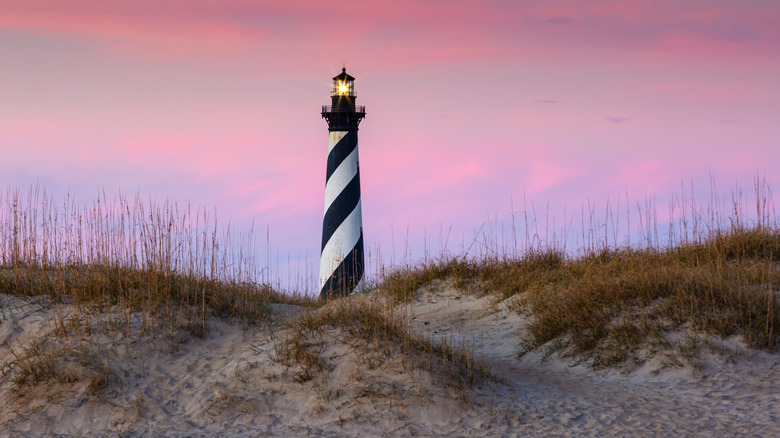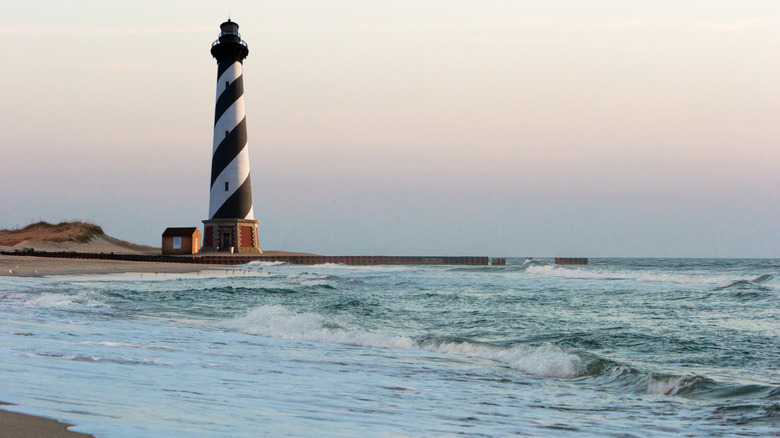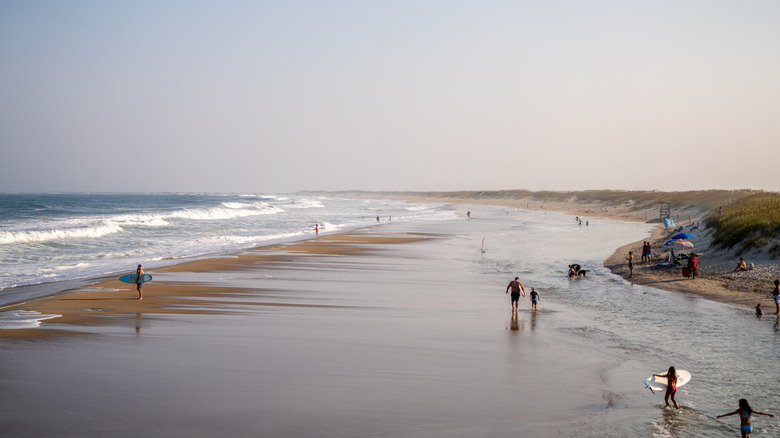A Stunning Stretch Of Beaches In North Carolina Is Home To America's Tallest Brick Lighthouse
For a country with more than 95,000 miles of shoreline, the United States has surprisingly few beaches designated as national seashores. There are just 10 in total, including Cape Hatteras National Seashore in North Carolina's Outer Banks, the very first to be selected by Congress in 1953.
Like its counterparts on Cape Cod, Fire Island, and Assateague Island, Cape Hatteras was chosen as a national seashore in part for its wildlife habitats — 30,000 acres of woods, salt marshes, beaches, and sand dunes are home to more than 360 bird species — as well as its cultural and historical significance. Three lighthouses rise up on the coastline, one of which is the tallest brick lighthouse in the country. It's also one of the tallest of its kind in the world, second only to the Świnoujście Lighthouse in northwest Poland. Built in 1870 using around 1.25 million bricks, the Cape Hatteras Lighthouse is nearly 200 feet tall.
If you're interested in visiting other national seashores, check out this wild Cape Cod stretch with sandy dunes and spectacular sunsets, or consider visiting this Gulf Coast seashore with clear waters and outdoor adventures.
Moving the country's tallest brick lighthouse
There's a good reason that the lighthouse was built along this particular stretch of coastline. According to a report to Congress in 1806, the region was especially treacherous for seagoing vessels and posed a high risk of shipwreck. In fact, Cape Hatteras has an ominous nickname — "Graveyard of the Atlantic" — due to the thousands of shipwrecks that have been recorded in the area over the years.
What makes the spiral-striped black and white landmark even more impressive is the fact that it was moved a half-mile inland in 1999. Due to naturally occurring shoreline erosion, the lighthouse, once 1,500 feet from the water's edge, had become dangerously close to the surf. The tower was partly dismantled and slowly moved to a location farther from the crashing waves, ensuring its safety for another century. If the Cape Hatteras Lighthouse has piqued your interest, consider planning another getaway for a beach-bound road trip around Cape Cod's most charming lighthouses.
Climb, camp, kayak, and bike near Cape Hatteras
Visitors won't be able to enter Cape Hatteras Lighthouse in 2025, as the historic landmark is undergoing an 18-month restoration project. But the grounds are open to admire the tower from the outside before exploring the national seashore's three barrier islands: Bodie Island, Hatteras Island, and Ocracoke Island. All three feature beautiful beaches and nature trails, and Bodie Island has its own lighthouse you can climb ($10) for sweeping views over the sea.
Cape Hatteras National Seashore is free to enter, though parking fees may apply. Camping is available at Cape Point Campground, about a 5-minute drive or a 35-minute walk from the Cape Hatteras Lighthouse, for $20 per site. Campgrounds nearby at Oregon Inlet, Frisco, and Ocracoke Campgrounds have sites from $28 per night. Other convenient lodging options are the elegant Inn on Pamlico Sound ($260 per night), about a 10-minute drive from the lighthouse, or the budget-friendly Hatteras Island Inn ($155 per night), a 5-minute drive.
Many visitors arrive at Cape Hatteras National Seashore by car, as the area is remote and not well-served by public transportation. The closest airport is Norfolk International Airport in Virginia (a 3-hour drive). Once on the barrier islands, you'll need a car to cover longer distances, but biking can be a great way to get around. Slash Creek Outfitters offers rental bikes for $10 an hour or $55 a week. The same outfitter rents kayaks, beach gear, stand-up paddleboards, and golf carts, and runs guided kayak tours at sunset ($50 per person).


